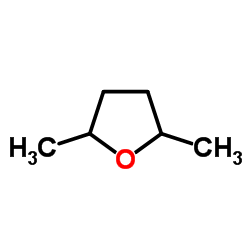2,5-DIMETHYLTETRAHYDROFURAN

2,5-DIMETHYLTETRAHYDROFURAN structure
|
Common Name | 2,5-DIMETHYLTETRAHYDROFURAN | ||
|---|---|---|---|---|
| CAS Number | 1003-38-9 | Molecular Weight | 100.159 | |
| Density | 0.8±0.1 g/cm3 | Boiling Point | 91.0±0.0 °C at 760 mmHg | |
| Molecular Formula | C6H12O | Melting Point | -45ºC | |
| MSDS | USA | Flash Point | 26.7±0.0 °C | |
| Symbol |

GHS02 |
Signal Word | Warning | |
|
Activation of transient receptor potential vanilloid 3 channel suppresses adipogenesis.
Endocrinology 156 , 2074-86, (2015) The present study shows that activation of the transient receptor potential vanilloid 3 channel (TRPV3) suppresses adipocyte differentiation. We also found that a major functional catechin compound in green tea and cocoa, (-)-epicatechin, exerts antiadipogeni... |
|
|
The reverse of the 'repair' reaction of thiols: H-abstraction at carbon by thiyl radicals.
Int. J. Radiat. Biol. Relat. Stud. Phys. Chem. Med. 51(1) , 91-102, (1987) Thiyl radicals (RS) formed by the reaction of radiolytically generated OH radicals with thiols, e.g. 1,4-dithiothreitol (DTT), react with cis- and trans-2,5-dimethyltetrahydrofuran by abstracting an H atom in the alpha-position to the ether function (k approx... |
|
|
One-step catalytic transformation of carbohydrates and cellulosic biomass to 2,5-dimethyltetrahydrofuran for liquid fuels.
ChemSusChem 3(5) , 597-603, (2010) Existing technologies to produce liquid fuels from biomass are typically energy-intensive, multistep processes. Many of these processes use edible biomass as starting material. Carbohydrates, such as mono- and polysaccharides and cellulose, typically constitu... |
|
|
Mechanistic study of a one-step catalytic conversion of fructose to 2,5-dimethyltetrahydrofuran.
Chemistry 18(39) , 12363-71, (2012) Carbohydrates, such as fructose, can be fully dehydroxylated to 2,5-dimethyltetrahydrofuran (DMTHF), a valuable chemical and potential gasoline substitute, by the use of a dual catalytic system consisting of HI and RhX(3) (X=Cl, I). A mechanistic study has be... |
|
|
Kinetics and thermochemistry of 2,5-dimethyltetrahydrofuran and related oxolanes: next next-generation biofuels.
J. Phys. Chem. A 116(18) , 4528-38, (2012) The enthalpies of formation, entropies, specific heats at constant pressure, enthalpy functions, and all carbon-hydrogen and carbon-methyl bond dissociation energies have been computed using high-level methods for the cyclic ethers (oxolanes) tetrahydrofuran,... |
|
|
Independent generation and reactivity of 2-deoxy-5-methyleneuridin-5-yl, a significant reactive intermediate produced from thymidine as a result of oxidative stress.
J. Org. Chem. 65(15) , 4648-54, (2000) 2'-Deoxy-5-methyleneuridin-5-yl (1) is produced in a variety of DNA damage processes and is believed to result in the formation of lesions that are mutagenic and refractory to enzymatic repair. 2'-Deoxy-5-methyleneuridin-5-yl (1) was independently generated u... |